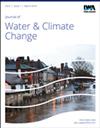Predicting the peak flow and assessing the hydrologic hazard of the Kessem Dam, Ethiopia using machine learning and risk management centre-reservoir frequency analysis software
IF 2.7
4区 环境科学与生态学
Q2 WATER RESOURCES
引用次数: 0
Abstract
Flooding due to overtopping during peak flow in embankment dams primarily causes dam failure. The Kessem River watershed of the Awash basin in the Rift Valley of the Afar region in Ethiopia has been studied intricately to predict the causes of the Kessem Dam safety using machine learning predictive models and Risk Management Centre-Reservoir Frequency Analysis (RMC-RFA). Recently developed recurrent neural network (RNN) predictive models with hybrid with Soil Conservation Service Curve Number (SCS-CN) were used for simulation of the river flow. Peak daily inflow to the reservoir is predicted to be 467.72, 435.88, and 513.55 m3/s in 2035, 2061, and 2090, respectively. The hydrologic hazard analysis results show 2,823.57 m3/s and 935.21 m; 2,126.3 m3/s and 934.18 m; and 11,491.1 m3/s and 942.11 m peak discharge and maximum reservoir water level during the periods of 2022–2050, 2051–2075, and 2076–2100, respectively, for 0.0001 annual exceedance probability (AEP). The Kessem Dam may potentially be overtopped by a flood with a return period of about 10,000 years during the period of 2076–2100. Quantitative hydrologic risk assessment of the dam is used for dam safety evaluation to decide whether the existing structure provides an adequate level of safety, and if not, what modifications are necessary to improve the dam's safety.利用机器学习和风险管理中心-水库频率分析软件预测埃塞俄比亚 Kessem 大坝的峰值流量并评估其水文危害
堤坝在峰值流量时因溢流而造成的洪水主要导致溃坝。埃塞俄比亚阿法尔地区大裂谷阿瓦士河流域的凯塞姆河流域经过深入研究,利用机器学习预测模型和风险管理中心-水库频率分析(RMC-RFA)预测凯塞姆大坝安全的原因。最近开发的循环神经网络(RNN)预测模型与土壤保持服务曲线数(SCS-CN)混合用于模拟河流流量。据预测,2035 年、2061 年和 2090 年水库的最高日入库流量分别为 467.72、435.88 和 513.55 立方米/秒。水文危害分析结果显示,2022-2050 年、2051-2075 年和 2076-2100 年期间的峰值下泄流量和最大水库水位分别为 2823.57 立方米/秒和 935.21 米、2126.3 立方米/秒和 934.18 米、11491.1 立方米/秒和 942.11 米,年超标概率 (AEP) 为 0.0001。在 2076-2100 年期间,Kessem 大坝可能会被重现期约为 10,000 年的洪水冲垮。大坝的定量水文风险评估用于大坝安全评估,以决定现有结构是否提供了足够的安全水平,如果没有,则需要进行哪些改造以提高大坝的安全性。
本文章由计算机程序翻译,如有差异,请以英文原文为准。
求助全文
约1分钟内获得全文
求助全文
来源期刊

Journal of Water and Climate Change
WATER RESOURCES-
CiteScore
4.80
自引率
10.70%
发文量
168
审稿时长
>12 weeks
期刊介绍:
Journal of Water and Climate Change publishes refereed research and practitioner papers on all aspects of water science, technology, management and innovation in response to climate change, with emphasis on reduction of energy usage.
 求助内容:
求助内容: 应助结果提醒方式:
应助结果提醒方式:


